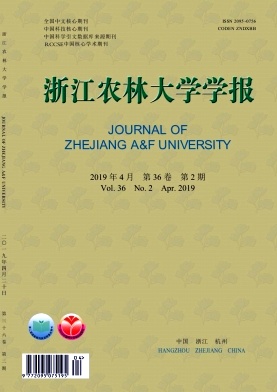-
菌根(mycorrhiza)是植物根系与土壤中某些特定真菌形成的共生体,能形成菌根的特定真菌称为菌根真菌[1]。菌根真菌能够与植物根系建立互惠共生体系,一方面从宿主植物获取碳水化合物,同时向植物提供土壤中的矿质营养,尤其是磷素[2]。菌根按照在植物体内的着生部位和形态特征分为内生菌根、外生菌根和内外生菌根[3]。丛枝菌根(arbuscular mycorrhizal, AM)是内生菌根中分布最广的类群,其胞内菌丝在根皮层细胞内及细胞间延伸形成丛枝状结构,可以和大多数植物共生,陆地生态系统中80%~90%的植物根系能够与其建立互惠共生体[4]。丛枝菌根真菌(arbuscular mycorrhizal fungi, AMF)分布广泛,高山地带、针叶林带、热带雨林、草原、农田都有分布,甚至在高度退化地区也有分布[5-6]。菌根是岩石矿物风化的主要因素,在岩石和矿物的风化进程中起着重要作用[7-8]。AMF定殖宿主根系有助于土壤养分活化,提高土壤肥力和水分供给能力,并且提供了活化养分转运至宿主植物的有效途径[9]。当土壤养分有效性低,养分被土壤颗粒及有机质吸附,AMF会活化这些养分[10],从而提高植物对磷、氮、钾、钙、硫、铜以及锌的吸收能力,促进植物生长。AMF被认为是一种天然生物肥料,可有效降低化学肥料投入,向宿主植物提供水分和养分,以交换光合产物[11]。研究表明:宿主植物接种AMF,根系吸收矿质养分能力提高,植物叶面积、根茎干质量增大,出苗率、果实产量以及矿质养分含量提高,土壤施肥量降低[12-13]。AMF是土壤—植物系统尤其是干旱和半干旱生态系统可持续发展的重要组成部分,在维持土壤养分和物质的生物地球化学循环以及确保植物健康和土壤质量方面发挥着重要作用。本研究通过总结丛枝菌根真菌对矿质养分活化作用效果,探讨AMF活化矿质养分机制及影响因素,认识丛枝菌根真菌在退化地区、困难立地中的应用潜力,为进一步深入研究AMF应用技术提供参考。
HTML
-
QUIRK等[8]研究了具有丛枝菌根的裸子植物和被子植物其林下玄武岩的风化程度:在AMF与植物共生作用下,玄武岩矿物表面呈现了风化隧道(tunnels),促进了氧化钙、碳酸钙溶解。丛枝菌根生态系统中,在长石、云母以及石英矿物颗粒上观察到了蚀刻坑(pits)和裂缝(cracks)或隧道,菌丝体围绕或进入矿物/有机质土壤颗粒或团聚体中,沿着构造薄弱点觅食矿物营养[14]。菌丝延伸,加速了矿物结构破坏、崩解,促进养分释放。古生物学证据表明:黑云母颗粒周围缠绕着AM菌丝,加速了黑云母蚀刻和风化[15]。BONNEVILLE等[16]借助扫描电镜观察到当菌根菌丝与矿物基质接触时黑云母晶格结构发生了显著蚀变。球囊霉属Glomus spp.丛枝菌根真菌与植物共生并与富钾黑云母互作,矿物中部分钾得到活化,根际黏土矿物X射线衍射图谱发现了多种低钾矿物:伊利石、蒙脱石和羟基化蛭石。菌根真菌能够选择性活化黑云母中钾以供植物吸收利用,同时未活化的黑云母还可以在以后得到进一步活化,成为有效态养分的储库[17]。蚀刻坑、裂缝或隧道的形成,使矿物结构不稳定,易导致生物风化,促进岩石矿物矿化、溶解。REMISZEWSKI等[18]使用双层网袋将植物根系与内置粉碎过筛的岩石矿物隔离,根系只能穿过网袋外层,而内层土壤溶液、微生物和菌根菌丝可以穿过,野外原位埋袋研究AM对岩石矿物养分活化效果。结果发现:AM侵染的糖枫Acer saccharum林下埋藏的花岗岩和闪长岩经过硝酸提取液处理,测得的缓效态镁、磷、钙都显著高于对照,AM菌根促进原位埋藏矿物溶解,使岩石中营养物质活化易于被硝酸提取。糖枫对钙需求比其他树种高,AM菌根有可能更易活化矿物中钙以供糖枫利用。
红三叶草Trifolium pratense与Glomus versiforme共生促进了CaHPO4·2H2O(Ca2-P),Ca8H2(PO4)6·5H2O(Ca8-P)和AlPO4·nH2O(Al-P)等常见难溶磷酸盐矿物溶解。菌根化植株使矿物磷具有更高活性,吸收矿物32P占总磷的13%~18%,与无菌根化植株吸收32P占总磷的0.24%~1.15%差异显著,菌根化植株磷质量分数(0.75~0.85 mg·kg-1)较非菌根化植物磷质量分数高(0.70~0.72 mg· kg-1)[19]。水牛草Bouteloua dactyloides在不同岩石矿物上接种根内球囊霉Rhizophagus irregularis,玄武岩中铁、钠、钛和铝活化量提高;植物菌根化处理的流纹岩中磷和锰活化效果显著高于未接种处理;花岗岩中钙和钾,片岩中钾分别达到很高活化效率。流纹岩中磷素被活化,水牛草地上部分生物量显著提高,植株锰元素浓度提高;玄武岩上培养的菌根化植物根系中转移更多磷、钾、钙、锰、铁、钛、铝[20]。植物与AMF互惠共生大大强化了矿物中营养元素的活化释放。
-
AMF能提高植物—土壤系统磷利用效率,减少养分淋溶损失。BENDER等[21]试验发现:AMF活化的土壤磷增加了18%,植物磷提高15%,磷的淋溶损失减少了31%。接种对提高土壤有机质含量、土壤微生物呼吸速率均有正效应,菌根效应间接改善了土壤微生物群落组成,提高有机质降解能力,促进养分释放。角豆树Ceratonia siliqua接种AMF,土壤氮、可溶性磷和可溶性碳都较未接种处理显著提高,土壤活化磷、氮、有机质分别较对照提高30.5%,27.3%和67.3%[22]。土壤中钾含量丰富,但由于土壤矿物强烈吸附导致有效态钾低。采用粒子-诱导X射线发射分析法(particle-induced X-ray emission)研究根内球囊霉菌根中钾分布,发现菌根孢子、菌丝和泡囊有大量钾离子富集,接种该真菌的三叶草Aster tripolium根段钾浓度高于未接种,说明AMF定殖提高了土壤钾活化效率[23]。
BENDER等[24]利用开顶式蒸渗仪系统进行控制试验,研究了土壤生物群落(土壤生物≤11 μm,微生物为主;土壤有机物≤2 mm,包含AMF)对土壤磷、氮养分有效性、淋失和植物生长的影响。结果表明:富含AMF土壤磷库量显著降低,磷活化量提高,达62.8 kg·hm-2,植株生物量显著提高,氮、磷养分增加,植物磷达121.8 kg·hm-2,增加72.3%。而微生物量少的土壤磷活化量只有30.5 kg·hm-2,土壤磷量仅为51.1 kg·hm-2。高微生物活性土壤AMF侵染率达70%以上。这说明AMF在植物磷营养的增加中起着重要作用,显著提高土壤磷素活化,促进植物对磷吸收,同时降低了氮素淋溶损失。且高微生物活性土壤有效磷量较低微生物活性土壤处理降低39.5%,乙酸铵-EDTA浸提磷量也降低,这充分说明AMF积极参与活化的土壤磷一部分被植物吸收利用,另一部分通过淋溶损失。土壤中磷的淋溶损失,可能是土壤磷矿化和活化增强的结果。洋葱Allium cepa与AMF(Gigaspora margarita, Glomus etunicatum)共生显著增加了土壤溶液中柠檬酸酸性物质分泌量,使添加的过磷酸盐中磷活化,全株磷质量分数较无菌根处理提高3.7倍和1.6倍,磷吸收增加971%和641%[25]。AMF通过与植物共生互作,对矿质养分活化产生作用,促进了植物生长。
AMF对不同养分元素活化具有特异性。芦笋Asparagus officinali接种摩西球囊霉Glomus mosseae,显著提高了土壤中钾、镁、锰元素有效性,增强芦笋根系从土壤中吸收这些元素能力,而锌吸收量却减少[26];接种AMF能显著提高菜豆Phaseolus vulgaris豆荚、芋头Colocasia esculenta球茎钾、钙、镁、锌、铜营养元素含量,而豆荚和芋头球茎对锰元素吸收都表现出显著降低趋势[27]。也有试验并没有发现AMF对有机氮源具有活化效应,但通过添加有机质和菌根真菌互作,提高了土壤酶活性并激发了微生物生长,改变了其种群结构从而促进了植物生长和氮吸收。SAIA等[28]采用向石英砂和土壤混合物中施加有机质,研究AMF对有机氮的活化效应。结果表明:通过接种摩西球囊霉,小麦Triticum aestivum组织中来自于添加的有机质氮量较对照处理低40%,有机氮没有得到活化,而土壤中碱性磷酸酶、脱氢酶、酪蛋白酶、BAA-蛋白酶活性提高,促进了植物生长,试验第7周菌根化小麦生物量较无菌根处理提高7%,第9周提高到20%,小麦氮吸收量提高。
1.1. 丛枝菌根真菌对岩石矿物养分的活化作用
1.2. 丛枝菌根真菌对土壤养分的活化作用
-
AMF外部菌丝在土壤中可形成广泛的菌丝网络。这些菌丝网络连接着同种或不同种植物根系,影响植物间矿质养分分配及水分调控[29]。菌丝定殖于根皮层,形成丛枝结构,这些丛枝结构是植物和菌根养分交换的重要场所,土壤中累计有菌丝100 km·kg-1,有的高达600 km·kg-1[30]。菌丝具有巨大的生物量和表面积,产生生物机械应力,从而演化形成通道或穿透矿物隧道[31],增强与岩石矿物相互作用,扩大植物根系吸收范围和根系功能。菌丝平均直径为2~20 μm,比根系小2个数量级,菌丝能进入直径较小根系不能进入的土壤孔隙内,吸收毛管水和矿质营养。菌丝穿插进入土壤小孔隙中,显著增加土壤水稳性大团聚体数量,改良土壤结构[32],使土壤孔隙溶液中保存更多养分和水分,增加菌根植物从土壤中获取养分潜力。根系周围由于根吸收作用降低了溶液中养分浓度,造成可溶性养分和土壤胶体吸附养分之间浓度差,形成匮养分区,导致交换态养分解吸。根外菌丝可以延伸到根毛所不及的土体中吸收养分,从而为宿主提供更多的水分和养分[33]。菌丝桥对磷、氮具有直接传递作用,在同种或不同种植物间进行传递,增加植物对不同形式氮利用,直接吸收氮并将其输送到宿主根系,从而实现养分再分配[34]。菌根侵染也促进营养物质活化运移,菌根真菌侵染宿主后能不断地为宿主提供磷素营养,宿主为菌根真菌提供碳水化合物保证其生长发育的能量,从而使菌根真菌不断侵染宿主根系,提高根系侵染率,提高菌丝的生长量和养分吸收量,促进植物生长发育[35]。
-
菌根能采取多种策略改变矿物组成并从中获取养分。菌根的重要变化途径是通过改变土壤溶液pH值、氧化还原状态等关键化学参数[36],分泌多种化学物质,如球囊霉素(glomalin)、低分子量有机酸等作为配体或载体,增强矿物溶解性和营养元素有效性[37]。
植物根系与菌根真菌共生产生有机酸和水解酶参与了有机质分解和矿物溶解,使菌根植物能获取非菌根植物无法活化的磷、氮形式[38]。接种AMF可以增强土壤磷酸酶活性,尤其是距根55~60 mm处酶活性比周围土壤酶活性高,活化土壤有机磷素,促进有机磷水解[35]。姜黄Curcuma longa接种AMF显著提高了酸性磷酸酶活性,接种90和150 d后酸性磷酸酶活性分别达18.11~21.19和18.33~21.39 μg·g-1·h-1。接种90 d后,根际土壤有效磷质量分数(7.10~8.50 mg·kg-1)显著高于对照(4.70~4.90 mg·kg-1),植株磷含量与土壤有效磷质量分数呈显著正相关(R2=0.83),酸性磷酸酶活性与根围菌丝也呈现高度正相关(R2=0.95)[39]。菌丝分泌物还具有溶解难溶性无机磷能力。TAWARAYA等[25]验证了菌丝分泌物的确能够活化难溶无机磷,收集的菌丝分泌物作用于FePO4,接种Gigaspora margarita根室和菌丝室释放的磷分别是1.74和1.49 mg·L-1,是对照的1.5和2.0倍;接种Glomus etunicatum根室和菌丝室释放的磷分别是1.55和1.57 mg·L-1,是对照的1.3和2.1倍。SMITH等[40]认为:菌根活化磷最重要的机理是菌丝利用铵根离子(NH4+)从而分泌其中的氢离子(H+),使土壤pH值降低,磷素得到溶解活化。AMF通过合成谷氨酰胺途径同化氨,这一过程可能对根外菌丝从土壤中吸收铵态氮产生明显影响。菌根植物地上部和根系中硝酸还原酶数量和活性都较无菌根植物高,说明菌根植物同化利用硝态氮能力较强[41]。
菌根分泌铁载体或低分子量螯合剂,铁离子(Fe3+)螯合还原酶活性提高,Fe3+配体提高铁溶解性,促进铁活化[42]。菌根分泌还原物质,使Mn(Ⅳ)还原至Mn(Ⅱ),增强矿物锰溶解和植物吸收[20]。与无菌根植物相比,菌根植物呼吸增强,释放出大量二氧化碳(CO2),生成碳酸(H2CO3)和HCO3-使土壤酸化,低pH值及菌根根际分泌的有机酸——柠檬酸、莽草酸、草酸、延胡索酸等使难溶养分元素易于活化,增加钾离子(K+),钙离子(Ca2+)和镁离子(Mg2+)等离子有效性,促进植物吸收[43]。低pH值下,氢离子(H+)更易进入含钾矿物晶层,取代释放其中的钾到土壤溶液中,提高其有效性。菌根真菌分泌有机酸总量与土壤矿物结构钾含量呈显著负相关,有机酸可能参与土壤矿物钾溶解释放;菌根真菌分泌的草酸含量与土壤缓效钾呈显著正相关,说明菌根真菌分泌的草酸对活化土壤无效钾很重要;分泌较多草酸可能有利于含钾矿物风化和矿物晶格钾释放,而分泌较多的H+可能有利于黏粒矿物层间钾交换[44]。
-
土壤微生物参与土壤一系列生物进程:有机质分解、养分转化、植物生长及土壤物理性质改变,AMF与植物共生影响土壤细菌群落结构和功能多样性。TOLJANDER等[45]向土壤中提取的细菌群落加入丛枝菌根菌丝分泌物——碳水化合物,采用细菌活力染色和荧光显微镜观察发现菌丝分泌物加快了细菌群落生长和活力,改变了细菌群落组成。王莉琴等[46]采用三叶草拌种接种丛枝菌根真菌于梨树Pyrus sorotina根部,发现菌剂没有改变土壤微生物群落结构,但显著增加各种微生物数量。
AMF可提高球囊霉素相关土壤蛋白(glomalin-related soil protein,GRSP)含量,GRSP是土壤重要碳储库,能将土壤颗粒和稳定性团聚体联系起来改善土壤结构,促进微生物群落细菌、真菌及放线菌的生长和繁殖[47]。AMF与根际促生细菌(plant grow promoting rhizobacteria,PGPR)和固氮菌存在着积极的协同作用,在AMF菌体(孢子、菌丝)上及细胞内部发现大量细菌、放线菌、甚至真菌类微生物,其中以细菌和放线菌数量最多[48],有些以菌丝相关细菌形式存在。这些细菌依赖于菌丝分泌物繁殖生长[49]。菌根真菌与固氮细菌协同作用,提高固氮植物固氮量[50]。AMF与细菌相互作用,通过菌丝提高根系长度,扩展土体体积,扩大根系吸收面积,强化磷酸酶矿化磷效率[9]。菌根真菌促进土壤微生物活性,引起植物根系生理代谢变化,对菌根根际微生物区系产生以养分为介导的选择作用,引起根际微生物区系组成和数量变化,从而促进了土壤结构形成和土壤养分释放。
-
根系形态改变对矿质养分活化、水分运移,宿主植物养分吸收和水分平衡具有重要作用。AMF能提高根系长度,扩大根体积,降低根尖分生组织活性,导致侧根数量增加[51]。苹果Malus pumila接种AMF,根系体积显著增加,形态发生变化,苗高、茎粗、叶面积、根茎干质量增加,植株吸取养分含量提高[52]。AMF通过改变根系形态,使植物能够适应和改变土壤微环境[53]。AMF接种也能通过调控离子转运通道而促进矿质养分活化及转运,养分由菌丝传递到宿主植物。莲花Nelumbo nucifera接种Gigaspora margarita,KT/KUP/HAK转运蛋白上调了44倍[54];盐胁迫下,通过AMF定殖,玉米Zea mays的SKOR通道也获得上调,矿质养分由根输送到地上部分,植物生物量、养分含量提高[55]。
2.1. 菌丝网络促进养分活化运移
2.2. 改善根际微环境促进养分增溶
2.3. 促进土壤微生物群落生长
2.4. 影响根系形态及调控养分转运蛋白
-
矿物化学组成影响菌根真菌对其活化效果,AMF活化矿物养分具有一定的选择能力。采用分室隔离同位素标记法可对菌根菌丝活化不同磷源及植物吸收进行示踪[19],32P分子标记无机磷矿化效果表明:接种根系菌丝穿过隔离室延伸至无机磷源室,活化了CaHPO4·2H2O,Ca8H2(PO4)6·5H2O和AlPO4·nH2O中磷,但对Ca10(PO4)6·F2中磷没有活化效果,菌丝在穿过隔离室觅食营养时对磷源具有趋向性,磷源促生菌丝伸长和数量增加,从而促进菌丝分泌螯合物或降低土壤pH值,促进磷源活化。
不同矿物晶形、组成结构影响AMF对其风化程度及元素释放效率,不同岩石矿物基质AMF处理活化矿质元素有显著差异,活化量与岩石矿物中元素总量没有直接相关性,却与矿物成分溶解度有关[56]。流纹岩中磷和锰总量较玄武岩低,与花岗岩和片岩相当,而菌根化植物活化磷和锰量显著高于其他3种岩石矿物;花岗岩和片岩活化的钾显著高于玄武岩和流纹岩,总钾最高的片岩(55.8 g·kg-1)钾获得较高活化效率,略低的流纹岩(37.3 g·kg-1)钾活化量却较花岗岩(34.5 g·kg-1)低。大量活化的镁、铁、钠、钛和铝向玄武岩上菌根化根系转移;磷、锰和硅的活化在流纹岩种植处理中最高;钾和钙在花岗岩种植处理中最高,而这些元素总量在相应岩石中并不是最高的[20]。元素矿化差异可能与不同类型岩石矿物溶解动力学有关。玄武岩中结晶矿物和橄榄石较富含石英和钾长石的流纹岩和花岗岩更易风化[57]。同一接种物下,玄武岩优先溶解活化释放较多矿质元素;磷总量较低的流纹岩中活化释放更多的磷也可能是磷灰石(磷源)优先溶解的原因;花岗岩和片岩活化的钾量高于玄武岩和流纹岩可能是黑云母易于溶解和植物营养需求量高所致。较低营养状况下AMF会发挥更大的活化作用,但AMF对低营养的流纹岩、花岗岩以及片岩的矿化没有产生明显影响,却在较高营养的玄武岩中有明显的矿化效应。岩石矿物养分含量过低,养分元素需要更长时间矿化溶解,菌根真菌的作用短时间内可能难以显现。
土壤物理性质及化学性质(颗粒表面积、体积、温湿度、酸碱性以及有机配体、养分浓度)都会影响AMF与植物共生进程,进而影响AMF的活化作用[58]。沙质土壤降低了AMF作用,使铜和铁有效性降低,而锰影响不显著。磷肥也显著影响AMF性能,当磷不足时,土壤活化锰和铁量降低,而铜影响不显著[59]。AMF溶解养分活性与土壤pH值有关,不同pH值土壤上分离的AMF活性不同,低pH值下,AMF具有较强的活化效应,中性土壤分离的摩西球囊霉几乎没有任何活化效应[25]。当植物生长在营养限制条件下AMF才能显著促进植物生长和养分吸收,高含量土壤磷条件下,非菌根植物生长量反高于菌根植物,表明高磷降低菌根效率,而低磷条件AMF有可能有利于植物吸收某些对光合作用、呼吸和木质化功能至关重要的微量元素[60]。高钙土壤上,接种AMF的苹果苗显著增加了对锌和铁吸收,而这些元素在石灰性土壤中含量匮乏[52]。
-
不同宿主植物及AMF对同一矿物风化作用强度不同。与AMF共生的裸子植物银杏Ginkgo biloba,红杉Sequoia sempervirens,水杉Metasequoia glyptostroboides和南洋杉Araucaria araucana对玄武岩的净矿化效率不同:水杉矿化效率最高,约0.01 μg·d-1,而银杏矿化效率呈现负相关。与AMF共生的被子植物鹅掌楸Liriodendron tulipifera对玄武岩有最大矿化效率,而挪威槭Acer pseudoplatanus矿化效率为-0.01 μg·d-1,表现为负相关。不同树种AM对方解石和白云石矿化速率不同[61]。不同植物根际微环境不同,共生AMF多样性丰富,对同一种矿物基质表现出不同矿化效果。
不同丛枝菌根真菌物种之间对矿物养分活化影响不一。植物和AMF共生体对不同类型矿物响应特点不同,具有不同菌根效应。煤矿矿渣基质上,Rhizaophagus intraradices显著促进了新排放煤渣和燃烧后煤渣中铜向菌根化根系转移,而风化煤渣上根系铜富集不显著,而锌和锰呈现显著负效应;Glomus aggregatum显著提高了新排放煤渣和燃烧后煤渣中锰向根系富集浓度,而在风化煤渣上锰的浓度较对照显著降低;不同AMF接种对基质中铁活化无显著影响[62]。AMF与宿主具有一定的偏好和选择性,Glomus versiforme对于提高苹果砧木生物量和养分元素具有显著的促生作用[52],而桃Prunus persica接种Glomus versiforme的效果却没有接种摩西球囊霉显著[63]。
不同菌根真菌具有不同生态功能,菌种之间对矿质养分活化存在协同促进作用[64]。对植物生长影响也因接种真菌种类不同而不同,混合接种比单接种促生效应大,能使植物获得更大生物量[65],混合接种有可能在提高根际土壤磷活性上较单一接种具有更积极的促进作用[39]。这说明混合接种能更积极促进矿质养分活化。同一宿主植物接种不同菌种,定殖率不同,养分吸收水平存在显著差异。这种差异可能源于菌丝类型和丰度差异,或是根系形态、根系分泌物或与AMF兼容性造成[52]。AMF具有不同的菌丝生长模式、分支频率,这些差异可能反映了菌丝不同营养策略和对土壤中不同生态位的反应。
矿物基质具有不同的物理化学性质,矿质元素赋存形态不一,而不同AMF具有不同生态功能。矿物基质-AMF-宿主三者共生体系养分协调分配利益最大化才能获得最高效的生态效应。
-
AMF不能进行光合作用,只有淀积植物光合产物一定数量碳才能生长,作为交换,菌根真菌提供给植物矿质营养和水分[66]。不同生长环境条件及宿主分配给AMF碳量不同,进而影响AMF发育,影响土壤养分活化。宿主光合产物碳能增加菌根真菌碳通量,驱动矿物风化,促进矿物溶解。通过14CO2示踪试验,观察到随着菌根根系14C通量提高,相应玄武岩中硅酸钙溶解速率增加2.4倍。光合产物碳分配到菌根菌丝网络,促进菌丝生长,作为回馈,菌丝加速了硅酸盐矿物溶解,活化矿质养分供宿主生长[67]。有研究表明:提高空气中二氧化碳分压,能提高AMF对土壤氮素利用,提高宿主氮营养[68]。气候类型也影响AMF对土壤养分活化。热带和亚热带地区,AM森林土壤碳矿化速率增大,矿化碳量显著高于温带,而温带地区矿化不显著[69];温度较高地带,AM呼吸增强,碳源促进AMF生长繁殖,菌根作为通道将碳从宿主植物中“导出”,并转移到土壤碳库中,碳源的分配影响了土壤中碳储量。
3.1. 矿物土壤类型
3.2. 菌根真菌及宿主种类
3.3. 碳源分配
-
土壤退化包括土壤侵蚀、贫瘠化、盐碱化、沙化、酸化、石漠化[70]。退化土壤养分循环指数降低,氮磷易于淋失,氮利用效率低[71]。AMF与植物共生强化了宿主植物对养分的吸收能力,尤其在不利土壤上发挥作用更大。菌根网络侵染的土壤能够提高植物获取水分和矿质养分能力,特别是移动性差或土壤溶液中浓度低的养分元素[9]。菌根活化土壤养分能力可能与养分供应水平有关,低养分条件下更有利于土壤养分释放,营养缺乏条件下,菌根真菌生长和发育更容易获得不同程度提高[72]。AMF生物技术是显著提高退化土壤生态恢复的一种潜在机制,能够显著提高土壤质地,增加地上地下生物多样性,提高乔木和灌木幼苗成活率,在水分和养分胁迫的土壤上易与定植,推动植物演替,防止外来物种入侵[73]。
-
AMF对生物胁迫具有抵抗作用,影响土壤离子平衡,能控制有害元素吸收。盐胁迫下,菌根根际土壤电导率值降低,植物对营养元素吸收增强,光合作用和水分利用率提高,植物抗过氧化酶活性增强,钾钠比值提高,细胞间离子平衡改变,使得钠流出植物体,减轻地上部分盐害,提高植物耐盐碱能力[74];铝胁迫下,菌丝体能富集铝,可将其定殖在植物皮层细胞内或固定在磷酸盐颗粒上,起到金属过滤的作用[20],菌根分泌物抵抗铝胁迫发挥了重要作用,建立了抗铝防御机制[75]。
-
重金属胁迫下,菌根具有启动抗氧化防御系统,防止重金属引起的活性氧反应毒害;显著增加氮、磷、钾吸收,调节C:N:P化学计量比,减轻重金属毒害;菌根释放的球囊霉素不溶性蛋白质,菌根细胞壁中的壳素对重金属都具有固定作用[76]。
重金属处理与接种茄子Solanum melongena内的抗氧化物活性酶呈正相关,超氧化物歧化酶(SOD)从3.13×16.67 nkat·g-1提高到5.64×16.67 nkat·g-1,过氧化氢酶(CAT)从4.93×16.67 nkat·g-1提高到24.66×16.67 nkat·g-1,抗坏血酸过氧化物酶(APX)从9.02×16.67 nkat·g-1提高到30.08×16.67 nkat·g-1。氧化酶活性的提高有助于平衡重金属胁迫引起的有毒氧衍生物产生[77]。菌根是重金属富集的重要储库,菌丝具有巨大的表面积,单位质量菌丝能固定镉0.5 g·g-1[78]。铅污染土壤上,AMF接种的相思树Acacia saligna干质量增加,株高、总氮、磷、钾以及叶绿素提高。接种提高了植物对铅的吸收和富集,防止由于铅增加造成的毒害[79]。肥力低下的矿区土壤接种AMF,红花槭Acer rubrum侵染率达80%,吸收面积扩大,菌根植物的13种元素含量增高,生物量增大。樱桃Cerasus pseudocerasus和山楂Crataegus pinnatifida等通过接种菌根真菌,植物养分吸收增强,生物量增加,土壤中有效态氮、有机物养分提高,酸性磷酸酶、蔗糖酶、尿素酶、硝酸还原酶活性增强[80]。SOARES等[81]认为:AMF能提高植物对重金属胁迫的耐受力,很大程度上是通过调控磷营养实现的。菌根细胞壁中游离氨基酸也可能是提高重金属吸附的因素,游离氨基酸具有带负电荷的羟基、羧基官能团能够与重金属阳离子结合[82]。
-
AMF与宿主共生是通过代谢和生理变化改善植物一系列生理参数,从而抵御干旱胁迫:增强组织水分和气孔导度,提高光合能力,改善渗透调节物质或增强氧化应激缓解能力[83]。
AMF通过改善植物磷营养,同时影响土壤大团聚体的形成和保持水稳性团聚体稳定而调节土壤结构,增加宿主体内糖类含量,降低渗透势,提高植物体内可溶性糖含量,保持植株体内水分[84]。半干旱生态系统中,球囊霉属真菌显著提高了植株体内羧酸和酰胺含量,低分子量有机酸促进土壤可溶性磷和氮溶出,改善了植物生长和营养状况,并为养分循环和抗逆创造有利土壤微生物环境[85]。与AMF共生,干旱胁迫下植物需水量减少了42%[86],机理是水通道蛋白基因在缺水状况下下调,减少了植物细胞水分损失[87]。地中海干旱胁迫下,角豆树Ceratonia siliqua与AMF共生提高了水分和养分吸收,引起植物组织水化;气孔导度和水分利用效率(超过90%)提高,高的气孔导度增强了植物吸收二氧化碳能力,提高光合效率,保持了组织水分和细胞膨胀,减少蒸腾损失的水分,维持植物生长和生物量;膜稳定性增强使细胞璧韧性提高,降低细胞膜损害;干旱胁迫下可溶性糖和钾累积改善了植物渗透调节能力;抗氧化物酶活性增强,避免由于水分胁迫引起的氧化损伤[88]。
在碳酸钙质量分数高达38.65%的土壤上,AMF具有显著的促生效应,苹果砧木叶片氮、磷、钙、镁、锌和铁含量与对照差异显著[52]。AMF真菌提高了植物在岩溶地区的适应能力,干旱及高钙双重胁迫下能加快胞间二氧化碳同化速率,增加叶片叶绿素含量,增大光化学反应速率,促进植物光合生长[89]。
4.1. 盐碱化生态系统
4.2. 重金属污染生态系统
4.3. 干旱及喀斯特生态系统
-
菌根真菌是陆地植物生态系统的重要组成部分,对提高土壤养分活性、促进植物吸收养分(尤其是磷),增强植物抗逆等方面发挥着重要作用。菌根真菌与植物是互惠共生关系,土壤是两者共生的营养物质基础,菌根真菌在养分贫瘠的立地条件发挥作用更大。然而养分过于贫瘠,真菌是否能真正发挥作用?发挥多大作用?在肥力较高的土壤上,菌根真菌作用小,菌根真菌促进土壤养分活化的土壤养分含量阈值范围需要深入研究。
菌根真菌促进土壤磷向植物转运,机理是菌根真菌分泌多种有机酸,使难溶性磷转变为植物可吸收利用的有效磷。而磷对植物的有效性在酸性土壤中是主要制约因素,平均效率仅为10%~20%[90],酸性土壤中铁、铝、锰含量高,磷容易被铁铝氧化物固定或吸附,磷有效性降低。AMF是植物获取磷源的主要驱动力[91],土壤酸性降低,土壤铁、铝、锰是否溶出更多,对磷是否更易固定、吸附,而菌根真菌是如何在这种情况下活化土壤磷,如何与铁铝锰胶荷竞争有效磷素,再转运至植物,有待深入研究。
盆栽试验为了防止土著菌种干扰试验,采用高压灭菌方式观察接种对矿质养分及植物影响,而自然状态下,菌根真菌发挥作用往往是与微生物协同作用的结果,AMF与微生物相互作用的方式和程度、贡献率还不清楚。对于丛枝菌根真菌的研究,今后应大力开展分离、鉴定退化土壤中丛枝菌根真菌遗传多样性研究,通过分子水平研究AMF分类,筛选退化地区具有较高养分溶出活性的优势菌属,为高效生态恢复提供优势菌种;探索菌根真菌脱离宿主植物离体条件下单独培养有关的孢子和菌丝发育的生理生态学规律;开展野外原位研究,量化菌根与其他微生物对矿物活化作用贡献,识别矿物活化过程中活跃和交互的生物群落;加强菌肥基础及应用研究,开发菌根与其他微生物共生生物肥料,利用混合菌根接种剂活化土壤养分,提高退化土壤养分利用效率。






 DownLoad:
DownLoad: